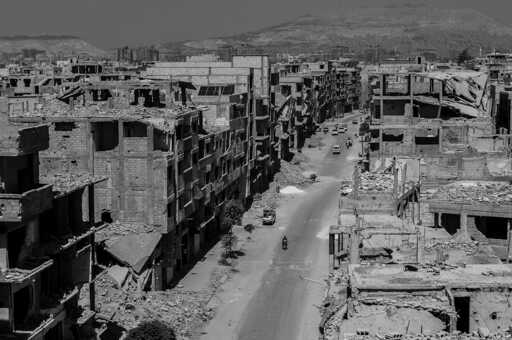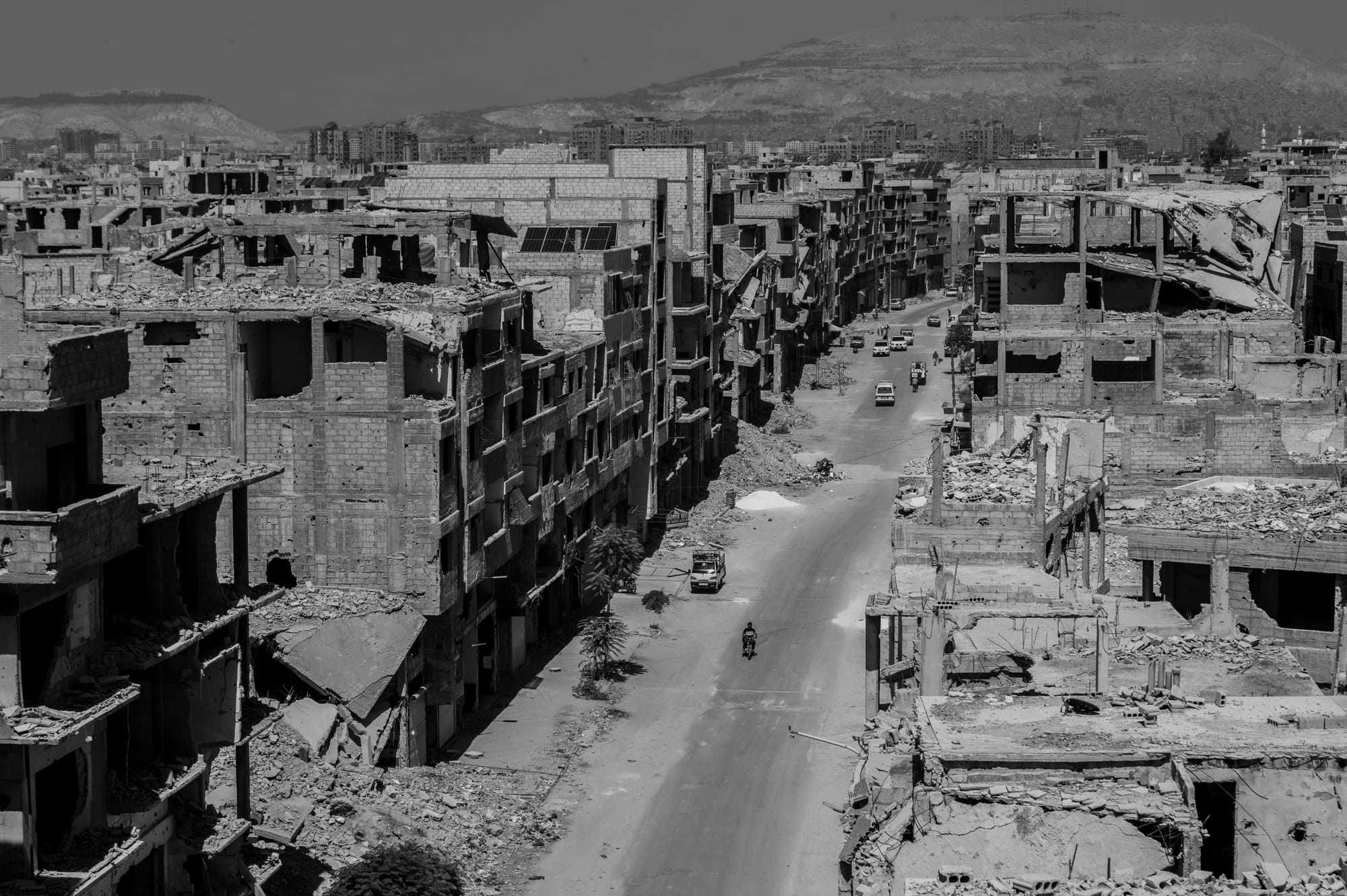
The suburbs of Damascus lie in ruins, and daily life unfolds amid dust, buildings reduced to rubble, and mountains of uncollected refuse. The collapse of the Al‑Assad regime pushed many Syrians to return to areas that had previously been off limits. After nearly a year under an interim government led by Ahmed al‑Sharaa, the country’s working class continues to wage a much less visible war, enduring miserable wages, runaway inflation, precarious labor conditions, and work environments that border on inhumanity.
Yarmouk, a Palestinian refugee camp, has become an orchestra of construction. Passing through the entrance arch, you hear the roar of bulldozers, the shouts of laborers coordinating their tasks, grinders cutting pipes, and the sparks from welding. Hundreds of workers seek employment amid the chaotic reconstruction of the city.
Suleiman, a 38‑year‑old worker, sits sipping tea in a corner with other workers waiting to be called to a job site. He travels every day from the city of Daraa to Damascus, a nearly two‑hour ride on public transit each way. Along with him, thousands of other workers come to the city to try to earn some money to feed their families—in Suleiman’s case, six children and his wife.
“We are the ‘free carriers’,” says Suleiman, pointing to his companions offering some tea, “Every day we come here hoping that a business owner or building contractor will hire us. Our usual task is to move construction materials, carry heavy bags of cement up to the top floors of buildings, or unload them from trucks.”
Beside him sits Mahmoud, age 28, perched on the edge of what once was a commercial storefront. The young man explains, “Not every day do we have the luck to work, but we must try because if you don’t work, you don’t get paid—we return home empty‑handed, and that means our family won’t eat.”
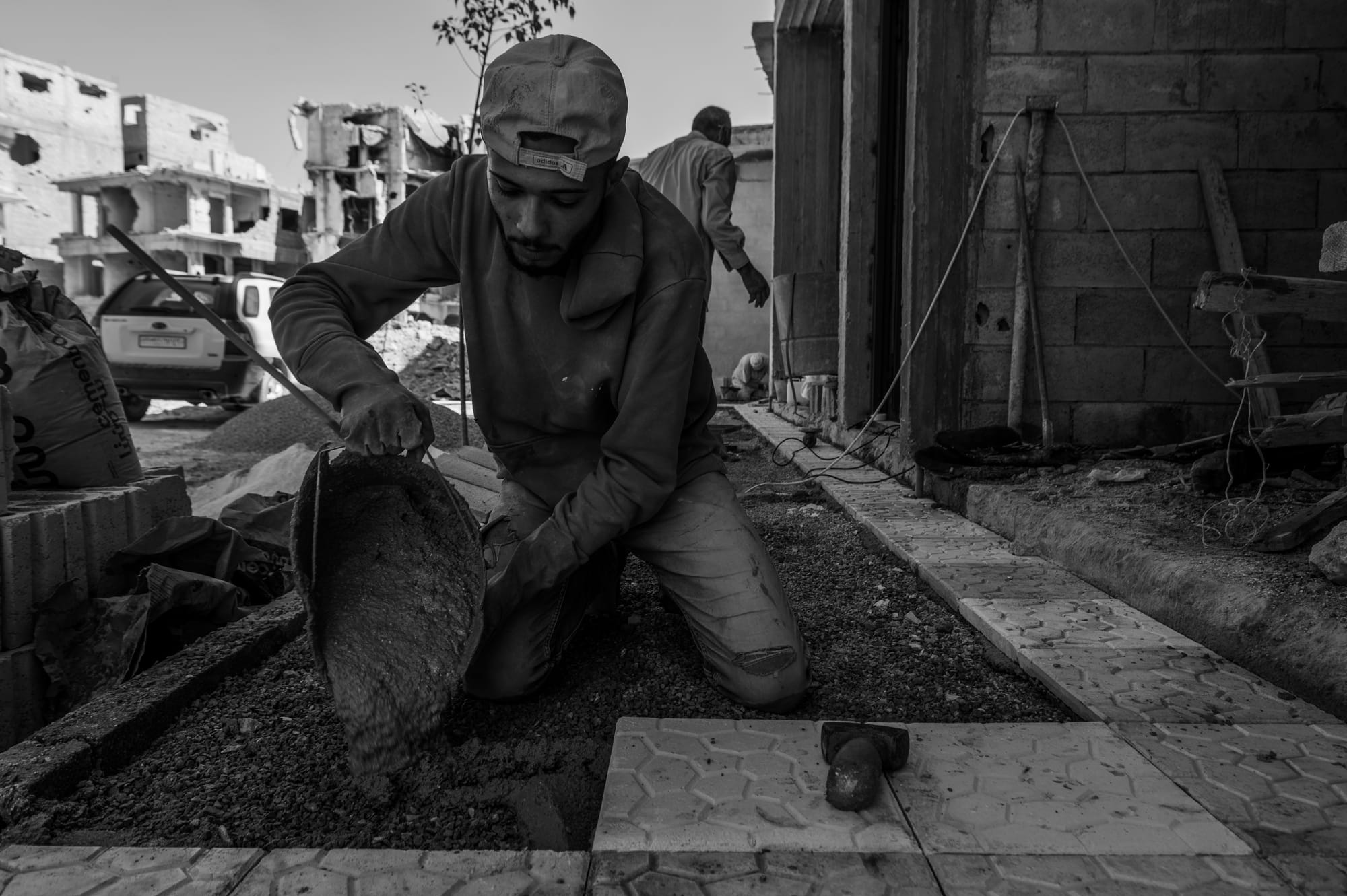
Worker laying tiles at the entrance of a rebuilt building.
Syria is devastated. Entire neighborhoods and cities have been pulverized after fourteen years of conflict. In 2011, what began as a workers’ and popular uprising for improvements in living conditions, later targeting the fall of the regime, turned into an armed conflict led by forces alien to the principles of the initial revolutionary process. The factions that fought the Assad regime, for the most part, despised left-wing organizations bringing with them political programs linked to radical Islamism.
During that time, millions of people fell into poverty due to the destructive consequences of war, international sanctions, and the Assad regime’s policies. His fall was broadly celebrated across the country, but it left behind a titanic task for the future. The change of authorities revived the revolutionary epic of 2011, accompanied by hopes for a better life, but that optimism was short-lived.
The transitional government led by Ahmed al‑Sharaa made clear from the start that “the revolution is over,” and now “it is time to build a nation.” The Swiss‑Syrian economist and writer Joseph Daher, author of several books including Syria after the Uprisings: The Political Economy of State Resilience, explains that the interim government reconciled with “certain prominent business figures affiliated with the former Assad presidential palace, such as Mohammed Hamsho, who historically acted as an ally and representative of Maher al‑Assad, and Salim Daaboul, owner of at least 25 companies”—both tied to the Assad family for some 40 years—thus preserving the business structure of the old regime and laying the foundations for a deeply neoliberal economic project.
These business groups are responsible for the drop in workers’ share of GDP from 30% in 2010 to 9% in 2023, according to the latest statistics. Approximately 16.7 million people need humanitarian assistance, according to the UN High Commissioner for Refugees, while over 90% of the population lives below the poverty line. These numbers illustrate the growing concentration of wealth and the widening gap between wage earners and large entrepreneurs and speculators—hallmarks of the new administration.
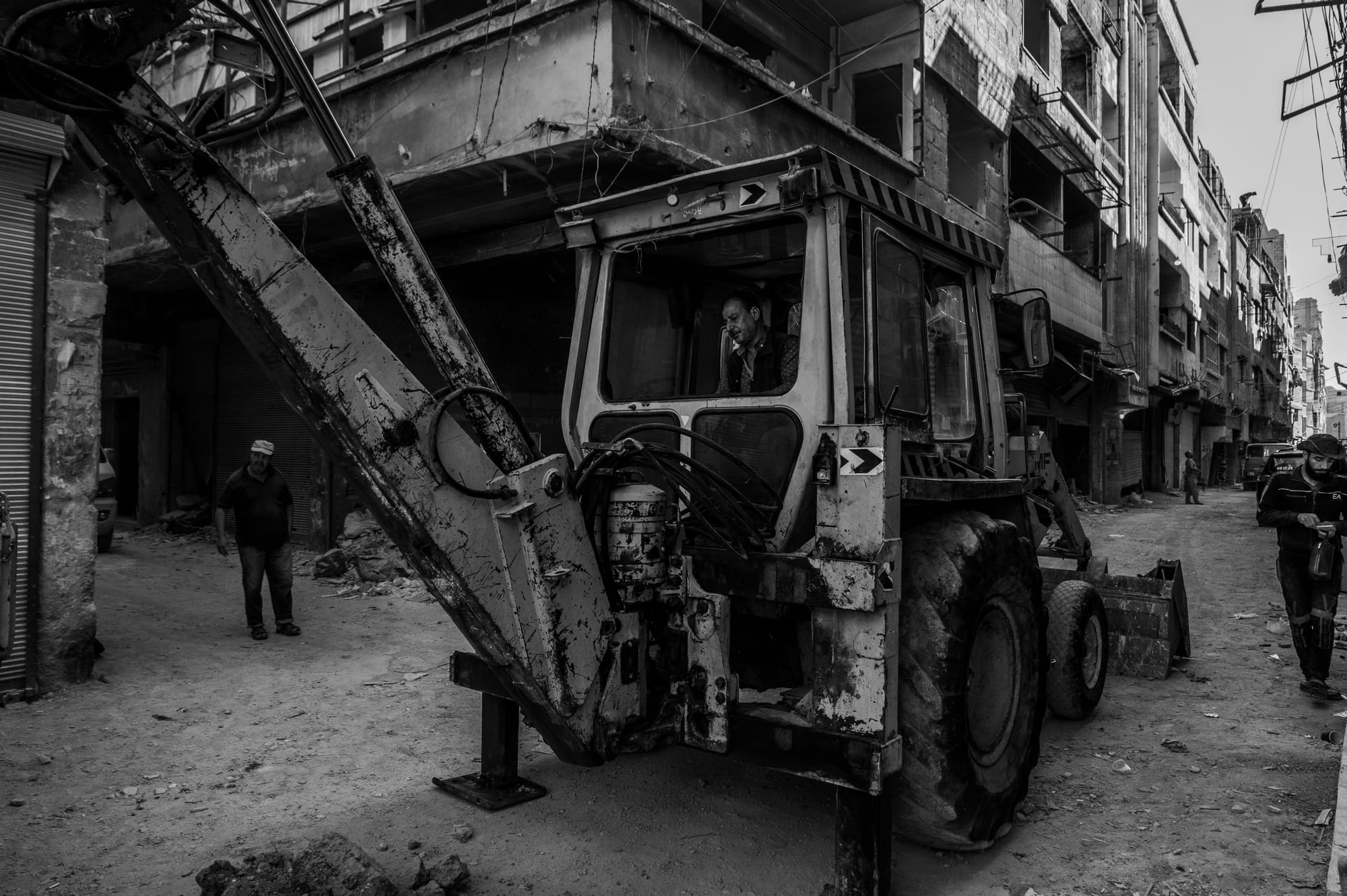
A contractor’s engineer breaks up the ground to find the sewer system.
Beasts of Burden
In the streets of Yarmouk, people slowly return to repopulate what was once called “the capital of the Palestinian diaspora.” This southern Damascus suburb once held more than a million inhabitants, but in 2012, after the massacre in the Abdelkhader mosque, only about 15,000 people remained, trapped under siege by the regime until it was fully evacuated in 2018.
Today, reconstruction is chaotic. Some NGOs are present in the area coordinating with the government to repair infrastructure, but most of the effort falls on private groups or individuals—in other words, family networks financing the reconstruction of their old homes.
Without gloves, without helmets, without proper clothing, these construction workers face a monumental task in repairing the ruins of fratricidal war. Driven into absolute informality, trapped between a devastated economy and a state apparatus that no longer guarantees services or rights, and with no contracts, no social security, and no possibility of organizing, most survive in workshops, construction sites, or small businesses that belong to a volatile parallel economy.
Under a scorching sun exceeding forty degrees in summer, “we carry blocks on our backs to the top of the building,” explains Suleiman. “Yesterday we carried over 500 blocks in one day; our bodies were exhausted,” he says, smiling and fanning himself with his hands. “We aren’t physically built enough to endure this work—many times we must rest for several days because the pain in our bodies is unbearable,” he said, showing his emaciated arms. “If we stay home, we don’t get paid. [That is why] what we fear most is having an accident or falling ill.”
Wassim, a 39‑year‑old house painter, says that right now “there is no help from the government to feed my two children and wife.” But what worries him most is that “there is no medical insurance—if something happens to me while working, it’s very dangerous for my family. I worry a lot about my retirement—what will happen to me when I am old and can’t move my body, because this work is so exhausting.”
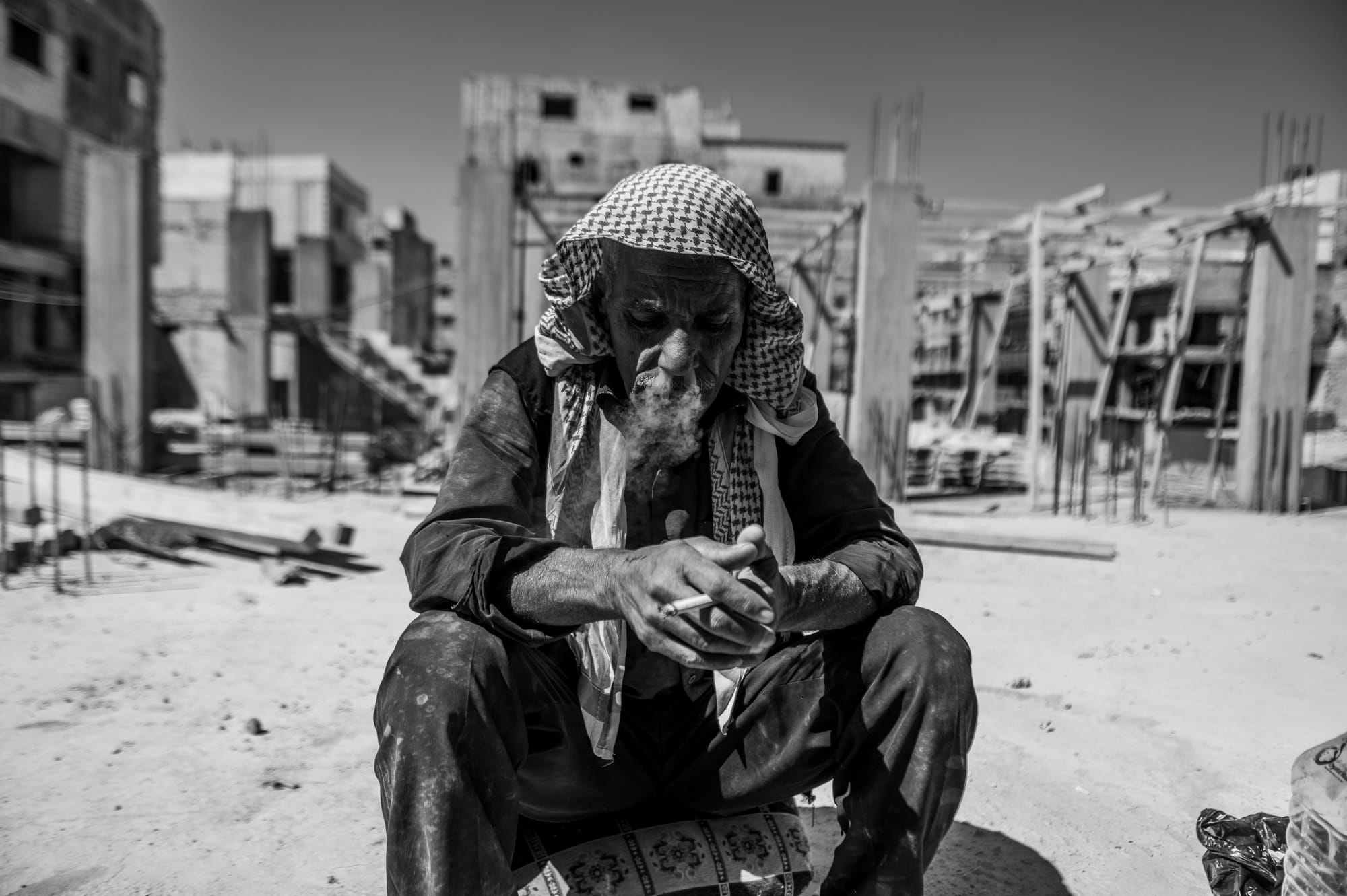
A bricklayer takes a break, smoking and drinking tea on the roof of a building in the afternoon.
Announcements of a 200% wage increase by Ahmed al‑Sharaa are not felt, given that austerity plans dominate, with cuts to subsidies and genuine price increases. But even the attempt at reforming the Syrian wage system went unnoticed. “For us, that doesn’t exist,” says Suleiman, trying to remove callus remnants from his hands. The new government’s economic vector has aimed at cutting subsidies, privatizations, and plans to lay off staff in state institutions. While the country tries to recover from the results of a catastrophic war, it is strangled by international sanctions and the austere legacy of the Assad regime.
According to estimates by the newspaper Kassioun, by late June 2025 the minimum cost of living for a Syrian family of five in Damascus reached about 9 million Syrian pounds (around $818) per month. The wages these workers earn don’t even approach what’s necessary to survive. “Per day, depending on who hires us, we are paid between 150,000 and 200,000 Syrian [pounds] [i.e. between $15 and $20], while for transport alone we pay around 50,000 [$5],” Suleiman details. “In total, we reach about $150 per month,” he says, doing his own calculations.
Subsidies for essential services like electricity, water, or fuel have also been reduced, while the price of bread has tripled since December last year. “Gas is very expensive, and also oil for heaters—next winter will be very hard for us,” says Suleiman.
Access to services at all is a privilege when electric lines or sewage systems are obsolete. “Those who have access to state‑provided electricity receive it only about four hours a day. Those who have a bit of money manage with solar panels, batteries, or other devices that only help charge cell phones or light up the darkness of night,” Mahmoud tells me.
Although the government attempts to prioritize rehabilitating basic services such as water lines, in practice reconstruction projects proceed slowly. Firaz, 43, is a contractor working to restore the sewage system in Yarmouk. He explains that “the infrastructure is completely destroyed; we have submitted a project to the government to restore it.” The contractor leads a small crew of ten workers “that depends heavily on donors, which stalls the work and therefore the payment of the men.” In the crew is Ahmad, 22 years old, who recounts, “We work about eight hours daily, for $20 each day; I also study Business Administration at the University of Damascus,” he says smiling, as he adjusts his cap. “After finishing the work in this pit we’re digging, I have to go to classes. Although the University is public, it’s not accessible to all, and for me it’s very hard to work and study.”
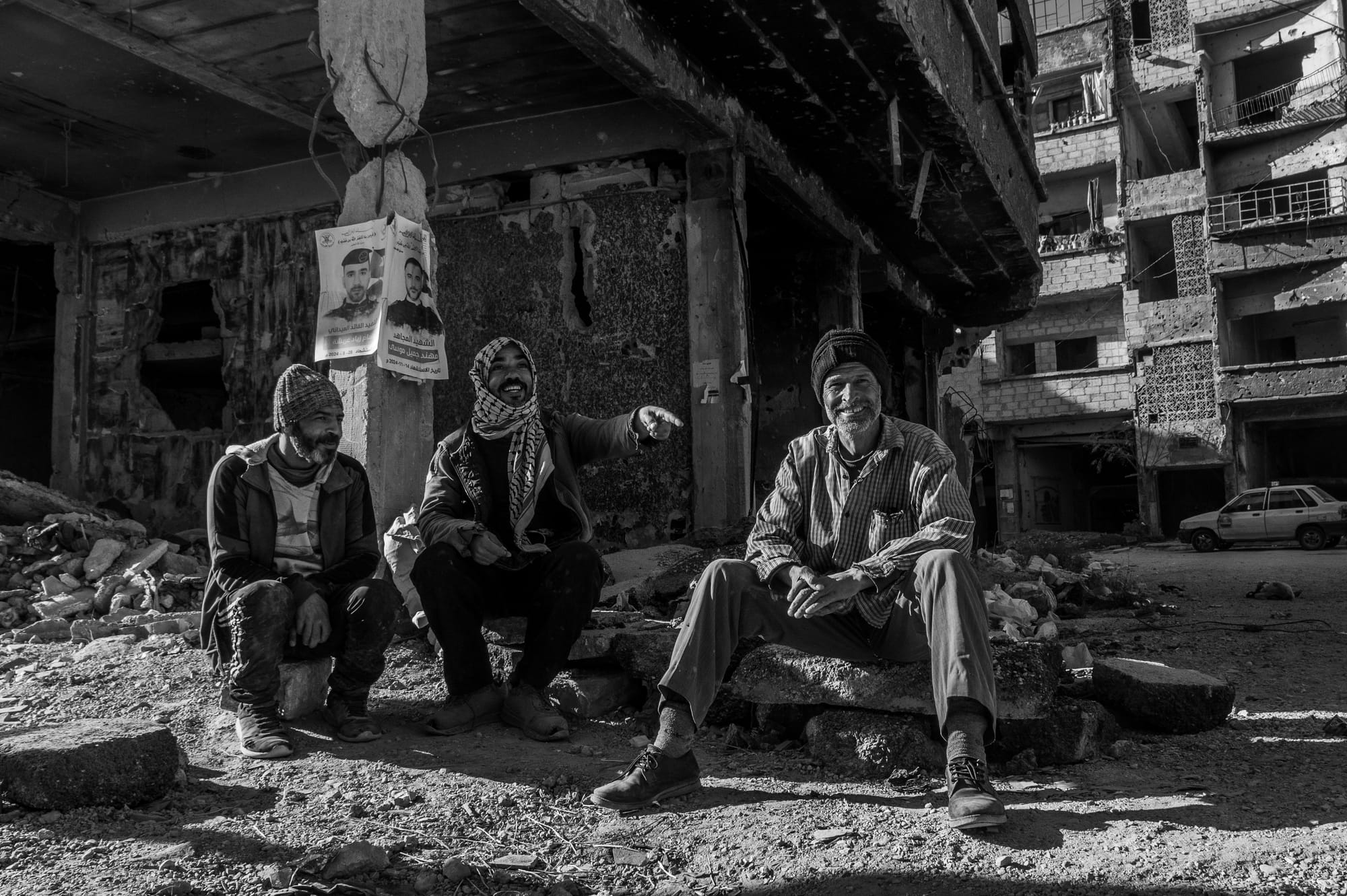
Free carriers wait for a new day’s work until the last minute.
The Impossible Organization
After decades under the Assad regime, Syria’s working class has been fragmented and disorganized. “We have no union, nor are there contracts or clear regulation, because we handle everything by word of mouth, day to day,” says Abu Qassem, 30, while taking a break inside the sewage pit. “We only seek to find a wage that allows us to live with dignity—the rights written down are just on paper; reality is very different.”
The neglect experienced by Syria’s working class is directly tied to the tight control the Assad regime exercised over unions. Furthermore, the political persecution during the 2011 revolution eroded union leadership. There is little hope that the interim government will enact change—on the contrary, the dissolution of unions and political parties has left the working class entirely politically disarmed.
Daher explains that “respect for workers’ rights is not a top priority” for al‑Sharaa. Instead, he is seeking to generate conditions ever more favorable to business chambers that degrade workers’ position further. “In late May, the Ministry of Economy and Industry issued a decision temporarily suspending the obligation of business owners and company directors to register employees in social security, claiming it simplifies procedures and encourages investment,” Daher details. The measure drew “criticism for undermining workers’ rights,” so “the ministry clarified that the measure does not eliminate the obligation but only suspends it till year’s end to promote registration with chambers of commerce.”
Another dimension undermining the possibility of organization is that in many rural regions and mid‑size towns—especially in the north and east—tribal relationships still play a central role in organizing work. Belonging to a particular clan can facilitate access to work or, conversely, block it if there are intertribal tensions. These traditional structures, far from disappearing in war, have gained renewed force in the institutional vacuum, replacing or controlling functions that once belonged to the state. Labor relations are also deeply marked by clientelism. Owners of factories, workshops, and fields—many connected with political, economic, or even military power networks—exercise paternalistic control over their workers, who depend on personal or family ties to keep their jobs.
However, another factor has marked Syria’s current situation and manifested itself in many instances since December 2024: sectarianism. This is common enough in the Middle East, where religion and politics are deeply intertwined, but it has played a particular role in the war in Syria, where social and state breakdown has often pushed individuals to seek refuge in their own religious communities, undermining any independent collective action by creating new barriers within the working class.
Blaming specific groups (based on sect or ethnicity) for the country’s problems and security threats justifies repressive policies. This pattern is evident in the massacres against Alawites on Syria’s coast in March and Druze in Suwayda in July. In this way, the new governing authority follows the steps of Assad’s former regime, continuing the use of sectarian practices as a means of governance, control, and social division.
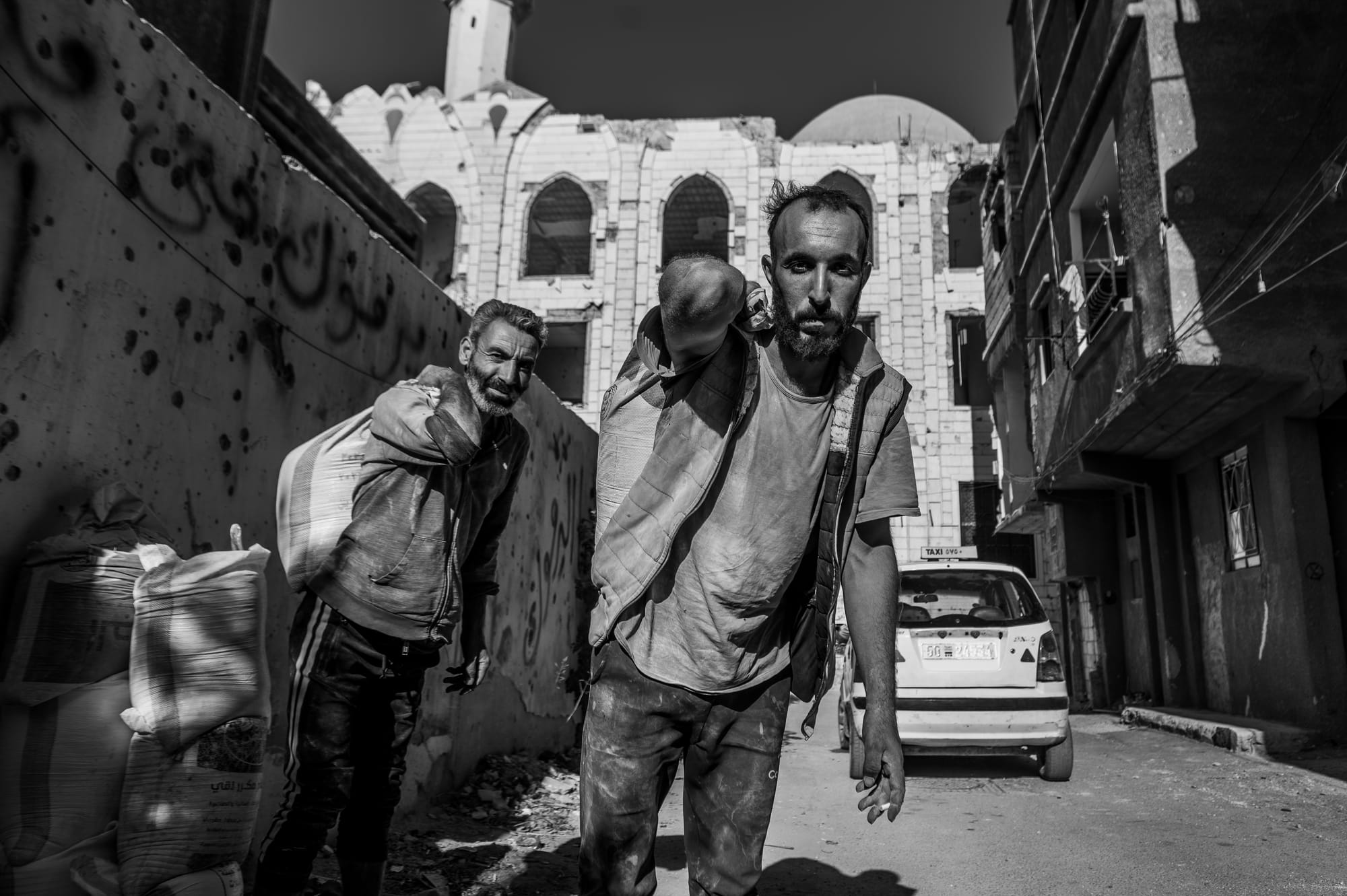
Free carriers moving construction materials near the Abdu Qader Al-Husseini Mosque in the Yarmouk camp.
In January and February of this year, there were sporadic protests over wages and firings, but the massacres in March and July muted them, “due to fear that armed groups close to or belonging to the new authorities will respond with violence,” again according to Daher. This situation has placed workers who are targeted because of their sectarian or ethnic affiliation in a vulnerable position. A recent example is the murder of four construction workers from the Alawite community in a village in Hama. There, families depend entirely on even lower wages, between 30,000 and 40,000 Syrian pounds per day. Despite their fear, workers must go out to earn a living, knowing that their lives are in danger.
Under such behavior, the al‑Sharaa administration will not change its policies or economic orientation, nor make real concessions in favor of the Syrian working class, unless there is a shift in the balance of forces that brings together democratic and progressive networks and actors to build political and counter‑power organizations in society. Ultimately, the new regime runs the risk of deepening socio‑economic inequalities, ongoing impoverishment, absence of democracy, and a lack of productive development. In other words, it is beginning a new cycle of reproducing the very factors that led to the outbreak of popular uprisings in 2011. Are they producing a new gravedigger?
Khaldoun al-Mallah contributed on the report.
■
Santiago Montag is an Argentine journalist and photographer specializing in the Middle East, based in Damascus. He has travelled extensively throughout the Palestinian territories, Lebanon, and Jordan in recent years. Since December 2024, following the fall of Bashar al-Assad, he has focused on covering the transition period in Syria.
From Damage via this RSS feed


